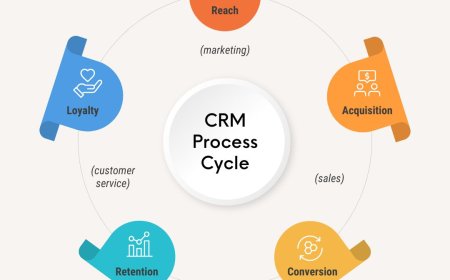AI Product Marketing Metrics That Matter: What to Track and Why
In the fast-paced world of AI product marketing, success isn’t just about launching innovative campaigns—it’s about measuring what truly matters.

In the high-stakes world of AI product marketing, success isnt just about clever campaigns or cutting-edge techits about measurable outcomes. Marketing AI products requires a data-driven mindset, yet many teams still struggle to identify which metrics truly matter. With AI buyers demanding proof of value and ROI, tracking the right metrics has never been more important.
This blog explores the essential AI product marketing metrics you need to track, why they matter, and how they inform strategic decisions. Whether you're launching a generative AI tool, machine learning platform, or analytics engine, these metrics will help you measure what countsand optimize accordingly.
Why Tracking the Right Metrics Is Critical in AI Product Marketing
AI products are complex, technical, and often abstract to buyers. Unlike traditional consumer goods, they dont sell themselves with slick visuals or catchy slogans alone. Buyersoften technical stakeholders like data scientists, engineers, or product managersneed clarity, education, and trust.
This means your marketing efforts must:
-
Educate through content
-
Nurture leads over longer sales cycles
-
Justify high-value investments
-
Highlight competitive differentiation
To succeed in this environment, marketers must go beyond vanity metrics (like impressions or likes) and focus on performance indicators that link content, campaigns, and conversion to actual revenue outcomes.
Core Categories of AI Product Marketing Metrics
Well break down the most critical metrics across six core categories:
-
Website and Traffic Metrics
-
Lead Generation and Funnel Metrics
-
Content Engagement Metrics
-
Conversion and Sales Metrics
-
Customer Retention and Loyalty Metrics
-
Revenue and ROI Metrics
Lets explore each category in depth.
1. Website and Traffic Metrics
Your website is the digital front door for your AI product. Monitoring how users find and interact with your site provides critical insights.
? Key Metrics to Track:
a. Unique Visitors:
Indicates reach and awareness. A spike in traffic after a campaign suggests successful exposure.
b. Traffic Sources:
Breaks down organic, paid, referral, social, and direct traffic. Helps you invest more in high-performing channels.
c. Bounce Rate:
Shows the percentage of visitors who leave after viewing one page. High bounce rates may signal irrelevant content or a poor UX.
d. Time on Page & Session Duration:
Indicates how engaging your content is. Longer sessions typically suggest stronger interest and clarity.
e. Pages per Session:
Reflects how well your site guides users through the funnel. More pages = more engagement.
? Why It Matters:
These metrics highlight the effectiveness of your content strategy, SEO efforts, and user experience. They serve as early indicators of marketing health and interest in your product.
2. Lead Generation and Funnel Metrics
Generating leads is the lifeblood of any AI product marketing strategy. But not all leads are created equal.
? Key Metrics to Track:
a. Marketing Qualified Leads (MQLs):
Leads that show a high intent to buy based on behaviors like downloading a whitepaper, attending a webinar, or requesting a demo.
b. Sales Qualified Leads (SQLs):
Leads vetted by sales teams as ready for a direct pitch. A strong MQL-to-SQL conversion rate reflects lead quality.
c. Cost Per Lead (CPL):
Total marketing spend divided by total leads. Critical for budget planning.
d. Lead Source Performance:
Tracks which campaigns, channels, or content pieces generated the best leads.
e. Lead Velocity Rate (LVR):
The growth rate of qualified leads over time. Helps assess momentum and forecasting.
? Why It Matters:
In the AI space, buyers need nurturing. These metrics help you assess how effectively you're attracting the right prospects and moving them through the funnel.
3. Content Engagement Metrics
Content is central to educating AI buyers. Whether its blog posts, whitepapers, webinars, or product videos, understanding how users interact with content is key.
? Key Metrics to Track:
a. Content Views and Downloads:
Basic indicators of reach and interest.
b. Average Engagement Time:
Tracks how long users spend consuming specific content.
c. CTA Click-Through Rate (CTR):
Shows the effectiveness of calls to actionwhether its signing up, requesting a demo, or reading related content.
d. Scroll Depth:
Reveals whether readers are engaging with long-form content or dropping off early.
e. Social Shares and Comments:
Indicate perceived value and resonance with your target audience.
? Why It Matters:
AI product buyers often engage with content multiple times before converting. Understanding which content drives the most action helps refine messaging and campaign priorities.
4. Conversion and Sales Metrics
While awareness and engagement are important, the ultimate goal is conversion.
? Key Metrics to Track:
a. Conversion Rate (Landing Pages, CTAs, Emails):
Measures the percentage of users who take a desired action. High-performing conversion rates often correlate with clear, targeted messaging.
b. Demo Requests / Free Trial Signups:
Critical conversion events in the AI buying journey. They often mark a transition from interest to intent.
c. Sales Cycle Length:
Time taken from initial touchpoint to deal closure. A long cycle isnt necessarily badbut understanding it helps optimize nurturing efforts.
d. Close Rate:
The percentage of SQLs that become paying customers. Indicates sales-readiness and marketing alignment.
e. Lead-to-Customer Rate:
Tracks the overall funnel effectiveness from initial lead to sale.
? Why It Matters:
These are the most actionable indicators of marketings contribution to revenue. They help you identify bottlenecks and optimize your lead nurturing strategy.
5. Customer Retention and Loyalty Metrics
In AI productsespecially SaaS modelsretention is just as important as acquisition.
? Key Metrics to Track:
a. Net Promoter Score (NPS):
Measures customer satisfaction and likelihood to recommend your product.
b. Customer Churn Rate:
The percentage of customers who cancel or dont renew.
c. Customer Lifetime Value (CLV):
Total revenue expected from a customer over time.
d. Product Usage Metrics:
How frequently users engage with key features can indicate satisfaction and product-market fit.
e. Onboarding Engagement:
Shows how effectively new users are adopting the product post-signup.
? Why It Matters:
Happy, engaged customers are more likely to renew, expand, and advocate for your product. Marketing should support ongoing education, community building, and value communication even after the sale.
6. Revenue and ROI Metrics
At the end of the day, marketing must prove its contribution to revenue.
? Key Metrics to Track:
a. Marketing-Attributed Revenue:
The total revenue generated from leads directly influenced by marketing.
b. ROI of Campaigns and Channels:
Revenue generated vs. cost spent on each campaign or channel.
c. Pipeline Contribution:
Percentage of sales pipeline sourced or influenced by marketing.
d. Customer Acquisition Cost (CAC):
Total spend to acquire a new customer. Ideally, CAC should be lower than CLV.
e. Return on Ad Spend (ROAS):
Revenue generated for every dollar spent on ads.
? Why It Matters:
These metrics prove marketing's financial impact. With AI product buyers often making large, considered purchases, aligning marketing spend with return is crucial.
Bonus Metrics: AI-Specific Considerations
Because youre marketing an AI product, you may want to track additional indicators unique to the space:
-
Tech Adoption Funnel Metrics: Track progress from awareness of AI to belief in its usefulness, to willingness to adopt.
-
Ethical Concerns Addressed: Measure how well content addresses common AI fears (bias, privacy, automation fears).
-
Use Case Relevance: Assess how well your messaging maps to real-world applications and industries.
Best Practices for Metrics Management
To get the most value from your metrics, follow these best practices:
-
Align Metrics with Business Goals: Dont measure for the sake of measuringfocus on what drives outcomes.
-
Use a Unified Dashboard: Combine data from Google Analytics, HubSpot, Salesforce, and your product analytics in one place.
-
Track Both Leading and Lagging Indicators: For example, engagement is a leading indicator, while revenue is lagging.
-
Set Benchmarks and Targets: Regularly compare current performance against past campaigns and industry standards.
-
Enable Cross-Team Visibility: Marketing, product, and sales should all have access to core performance data.
Conclusion
AI product marketing is a complex, high-value endeavor. In a space where prospects are analytical, skeptical, and data-driven, your marketing must be equally data-driven. Tracking the right metricsbeyond vanity figurescan be the difference between a successful launch and a missed opportunity.
By focusing on meaningful performance indicators across the buyer journeyfrom awareness to loyaltyyou can ensure that every campaign, every content piece, and every dollar spent contributes to business growth.













































